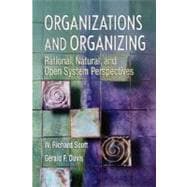This broad, balanced introduction to organizational studies enables the reader to compare and contrast different approaches to the study of organizations. This book is a valuable tool for the reader, as we are all intertwined with organizations in one form or another. Numerous other disciplines besides sociology are addressed in this book, including economics, political science, strategy and management theory.
Topic areas discussed in this book are the importance of organizations; defining organizations; organizations as rational, natural, and open systems; environments, strategies, and structures of organizations; and organizations and society.
For those employed in fields where knowledge of organizational theory is necessary, including sociology, anthropology, cognitive psychology, industrial engineering, managers in corporations and international business, and business strategists.
Features:
-Pays attention to organizational strategy, organizational conflict and political views of organizations
-Expansive coverage of globalization and the effects of trans-societal frameworks and processes.
-Written not exclusively from a management perspective, this text addresses managerial concerns while recognizing that all of us are legitimate stakeholders in organizations, whether as citizens, rank-and-file participants or customers/clients.








